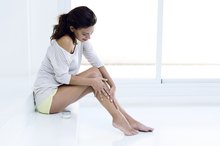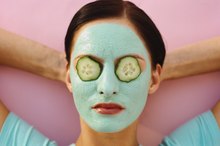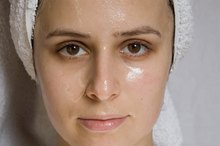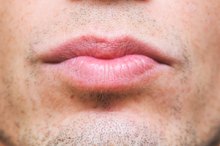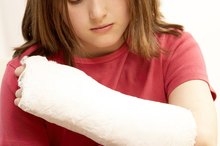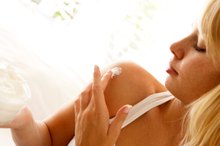How to Increase Blood Circulation & Reduce Cellulite
Cellulite describes the fatty deposits that most often occur on the hips, buttocks and thighs and create a dimply, orange-peel effect. One of the main causes of cellulite is poor circulation, the Healthy Exercise World website reports, which reduces essential nutrients to the area and weakens the skin's connective tissue. This is what causes the broken or dimpled appearance. There are no magical cures for cellulite, but a healthy diet, good skin-care routine and regular exercise can help reduce its appearance.
Body Brushing
Regularly brush your skin to increase the flow of blood to the skin's surface, the Women Fitness website suggests. This ensures that nutrients reach the surface area for healthy skin renewal. Brush dry or damp skin using a body brush with firm, but not overly coarse, bristles. Start at one end of your body -- either the head or the feet -- and brush the skin in sweeping motions toward the heart. The Natural Health Techniques website recommends you avoid broken skin. Apply less pressure on sensitive areas, such as the chest and neck. Brush your skin once a day.
- Regularly brush your skin to increase the flow of blood to the skin's surface, the Women Fitness website suggests.
Light Cardiovascular Exercise
How to Get Rid of Fat Dimples
Learn More
The important thing when doing cardiovascular exercise for cellulite reduction is not to exercise too hard or fast, but to maintain a steady pace over a reasonable period of time, the Woman Junction website advises. This will ensure you keep your heart pumping and muscles working long enough to start burning fat. You'll maintain a steady breathing rate which will increase the amount of oxygen you take in and further aid circulation. Walk at a reasonable pace for as long as you can without feeling exhausted, but aim to increase your pace and duration as your fitness improves.
- The important thing when doing cardiovascular exercise for cellulite reduction is not to exercise too hard or fast, but to maintain a steady pace over a reasonable period of time, the Woman Junction website advises.
- This will ensure you keep your heart pumping and muscles working long enough to start burning fat.
Eating Healthy
The National Institutes of Health (NIH) note that even though your genes may play a part in whether or not you have cellulite, your diet is another factor to consider. NIH recommends that you eat a healthy diet rich in fruits, vegetables, and fiber and stay hydrated with plenty of fluids to avoid developing cellulite. According to the Dietary Guidelines for Americans, established by the U.S. Department of Health and Human Services, a healthy diet also includes whole grains, low-fat dairy products, seafood and lean meats. Eat fewer foods processed foods and foods high in salt, saturated fast, trans fats, cholesterol and added sugars.
- The National Institutes of Health (NIH) note that even though your genes may play a part in whether or not you have cellulite, your diet is another factor to consider.
Related Articles
References
- Healthy Exercise World: Exercises For Cellulite
- Women Fitness: Top 10 Answers to Cellulite
- National Institutes of Health: MedlinePlus: Cellulite
- U.S. Department of Health and Human Services: Dietary Guidelines for Americans
- Dover, J. S., Orringer, J. S., Alam, M. (2014). Body Shaping, Skin Fat and Cellulite E-Book: Procedures in Cosmetic Dermatology Series. United Kingdom: Elsevier Health Sciences.
- Tokarska K, Tokarski S, Woźniacka A, Sysa-Jędrzejowska A, Bogaczewicz J. Cellulite: a cosmetic or systemic issue? Contemporary views on the etiopathogenesis of cellulite. Postepy Dermatol Alergol. 2018;35(5):442-446. doi:10.5114/ada.2018.77235
- Luebberding S, Krueger N, Sadick NS. Cellulite: An evidence-based review. Am J Clin Dermatol. 2015;16(4):243-256. doi:10.1007/s40257-015-0129-5
- American Academy of Dermatology Association. Cellulite treatments: What really works?.
- U.S. Food & Drug Administration. ZELTIQ CoolSculpting System 510(k). Published September 24, 2015.
- Zerini I, Sisti A, Cuomo R, et al. Cellulite treatment: A comprehensive literature review. J Cosmet Dermatol. 2015;14(3):224-40. doi:10.1111/jocd.12154
Writer Bio
Jessica began her writing career in 1995 and is Senior Editor at a London communications agency, where she writes and edits corporate publications covering health, I.T., banking and finance. Jessica has also written for consumer magazines including "Cosmopolitan" and travel, home/lifestyle and bridal titles. Jessica holds a Bachelor of Arts in English literature and journalism from the University of Queensland.

